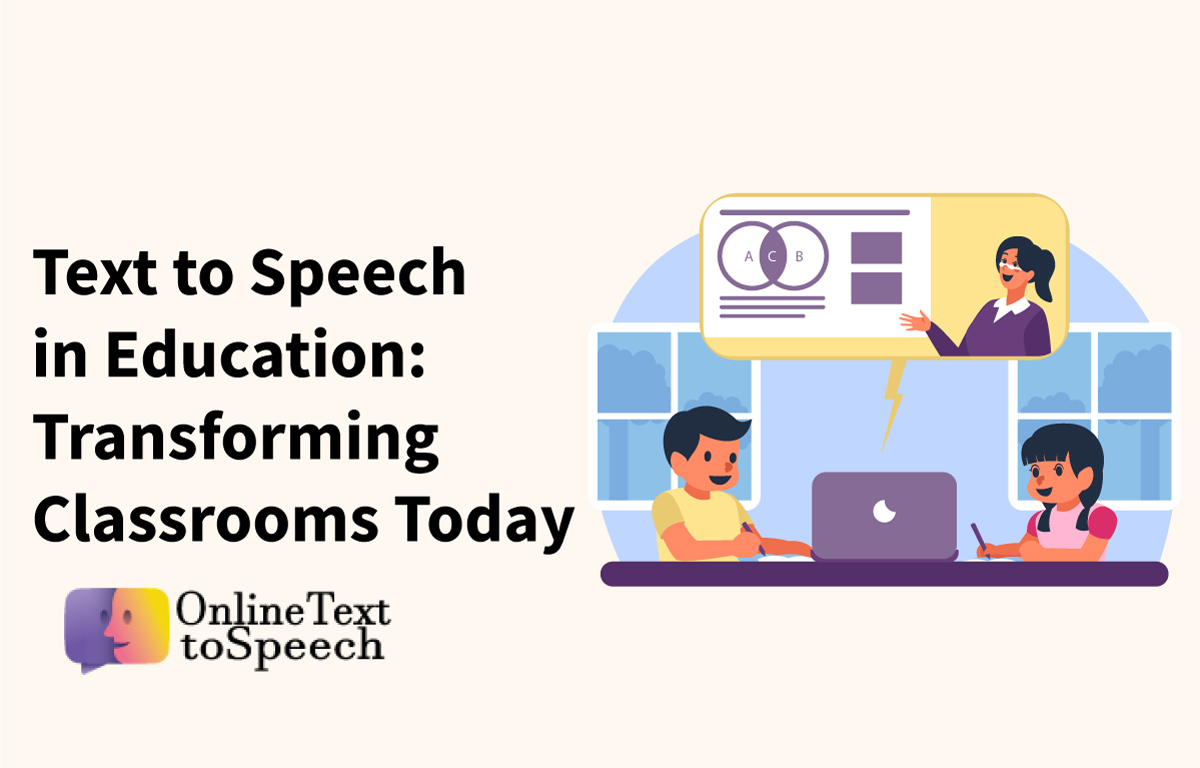
In the ever-evolving landscape of education, text to speech technology has emerged as a game-changer. By converting written content into audible speech, it empowers students with different learning needs to engage with their lessons more effectively. In this blog post, we’ll explore how this technology is revolutionizing classrooms, enhancing accessibility, and supporting learners from all walks of life.
As educators search for text to speech free solutions to make education more inclusive, it’s essential to understand how these tools are reshaping the way students access and process information. Let’s dive into the myriad ways text to speech can be integrated into today’s learning environments.
Why Text to Speech Matters in Education
Education is no longer confined to traditional teaching methods. AI text to speech technology offers a flexible approach to learning, making it possible for students to absorb content through multiple sensory channels. For learners with dyslexia or visual impairments, it transforms the way they interact with written materials. Imagine a student who struggles to read but can now listen to the same content with ease — that’s the power of text to speech.
Moreover, text to audio free platforms make this technology widely accessible. Even schools with limited budgets can integrate these tools into their curriculum, ensuring that every student benefits from improved accessibility and engagement.
Supporting Diverse Learners with Text to Speech
One of the greatest strengths of text to speech online technology lies in its ability to support students with diverse learning needs. Visual learners, auditory learners, and kinesthetic learners all benefit from having content presented in multiple formats. For instance, a student might read a passage while simultaneously listening to it, reinforcing comprehension and retention.
The availability of free online text to speech resources means teachers can easily incorporate audio into lessons without worrying about licensing fees or high costs. By pairing text with voice, educators can create more engaging and inclusive learning experiences that cater to every student.
Enhancing Language Learning and Literacy
Language learning is a key area where text to speech shines. Text to voice generator tools can help students develop pronunciation skills by reading aloud in a natural-sounding voice. Whether they’re learning English or another language, students can hear correct pronunciation and intonation, reinforcing their language acquisition.
Furthermore, text to speech voices have become incredibly lifelike, offering a range of accents and dialects to suit various learners’ needs. This versatility supports both native and non-native speakers, helping everyone to build confidence and fluency in their target language.
Personalized Learning with AI Text to Speech
Personalized learning is at the heart of modern education. With text to speech generator tools, teachers can customize the learning experience for each student. For example, they can select specific voices or adjust reading speeds to match a student’s pace. This level of customization not only keeps students engaged but also makes the learning process more enjoyable and effective.
AI text to speech technology is also a boon for students who prefer auditory learning. Instead of reading dense textbooks, they can listen to lessons on the go — a perfect fit for today’s mobile-first world.
Creating Accessible Classrooms for All
Accessibility is more than a buzzword; it’s a commitment to ensuring every student has the tools they need to succeed. With text to speech online platforms, teachers can convert digital documents, PDFs, and even handwritten notes into audio. This ensures that students with visual impairments or reading difficulties can participate fully in class activities.
Integrating free online text to speech into the classroom promotes equality, giving every learner the opportunity to access materials in the way that works best for them. By breaking down barriers, this technology helps create a more inclusive and supportive learning environment.
Integrating TTS with Educational Technology
The modern classroom is filled with digital tools — tablets, laptops, interactive whiteboards. Text to voice generator technology fits seamlessly into this landscape, enhancing existing digital resources. Teachers can use text to speech voices to create engaging audio lessons, quizzes, and study materials, making learning more interactive.
For educators seeking to empower their students, Online Text to Speech provides a user-friendly platform to create high-quality audio content quickly and easily. This ensures that every lesson is accessible and dynamic, whether it’s in the classroom or online.
Supporting Remote and Hybrid Learning
As schools embrace hybrid and remote learning, text to speech has become indispensable. Students learning from home can use text to speech free tools to stay engaged with their studies, even if they struggle with reading. By listening to lectures, articles, or homework assignments, they remain connected and motivated.
Teachers, too, benefit from this technology, as it allows them to produce audio materials that students can access anytime, anywhere. This flexibility is especially valuable in today’s fast-paced educational environment.
Overcoming Challenges with TTS Implementation
Despite its many benefits, implementing AI text to speech tools isn’t always straightforward. Teachers must ensure that the technology they choose aligns with their curriculum and meets their students’ needs. Accuracy in pronunciation, especially for complex subjects, is crucial.
Moreover, schools must provide adequate training for teachers to use text to audio free platforms effectively. This might include professional development sessions or integrating TTS into lesson planning. With the right support, TTS can transform classrooms and empower every learner.
The Future of Text to Speech in Education
Looking ahead, text to speech online technology is poised to become even more sophisticated. As artificial intelligence evolves, TTS voices will continue to sound more natural, offering authentic accents and emotional expressions that make lessons even more engaging.
Imagine a classroom where students can choose from a library of voices that cater to their learning styles — from calming narrations for focused study sessions to energetic voices that keep them engaged during lectures. That’s the future we’re heading toward.
Tips for Teachers Using TTS
Educators considering integrating free online text to speech should start by identifying key lessons or materials that would benefit from audio. Whether it’s reading assignments, test instructions, or multimedia presentations, TTS can enhance comprehension and accessibility.
Using a text to voice generator is also an excellent way to provide extra support for struggling readers or English language learners. Pairing visuals with audio can improve engagement and retention, helping students master new concepts more quickly.
Conclusion
Text to speech technology is transforming education by making learning more inclusive, personalized, and accessible. From supporting diverse learners to enhancing language skills and promoting independent study, its impact is undeniable. As technology continues to evolve, its role in education will only grow, empowering students and teachers alike to achieve their full potential.
Educators seeking to integrate TTS tools into their classrooms can find an easy and reliable solution at Online Text to Speech. With its intuitive interface and versatile features, it’s the perfect companion for creating dynamic, engaging, and inclusive lessons that cater to every student’s needs.
FAQs
Text to speech converts written text into spoken words, supporting students with various learning needs.
It offers an alternative way to access content, helping those with visual impairments, dyslexia, and other challenges.
Yes, there are many free online TTS platforms that make it accessible for all learners.
Absolutely! It improves pronunciation, listening skills, and overall language comprehension.
No, it can also be used for instructions, assessments, and even interactive lessons.



